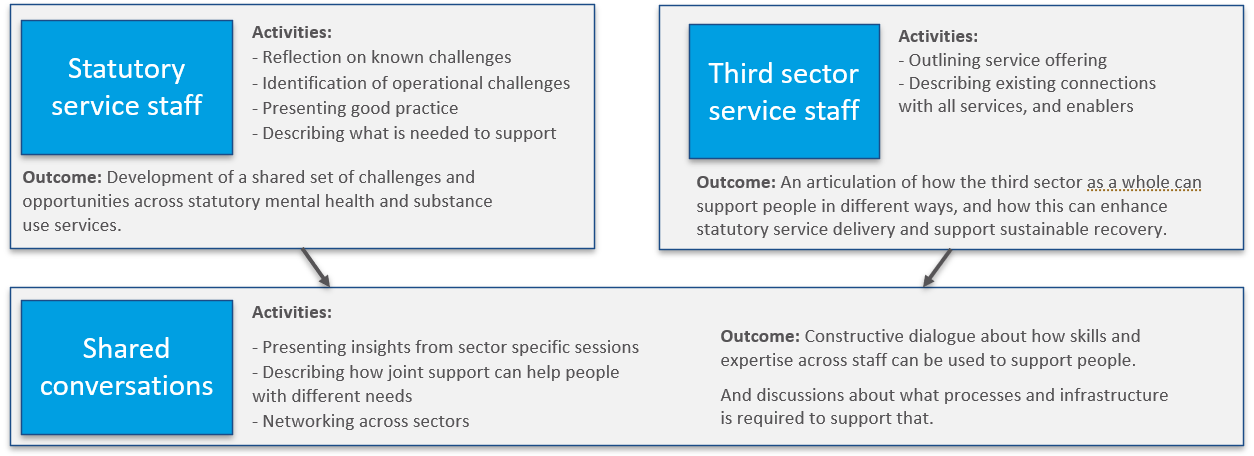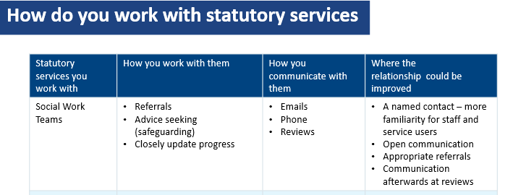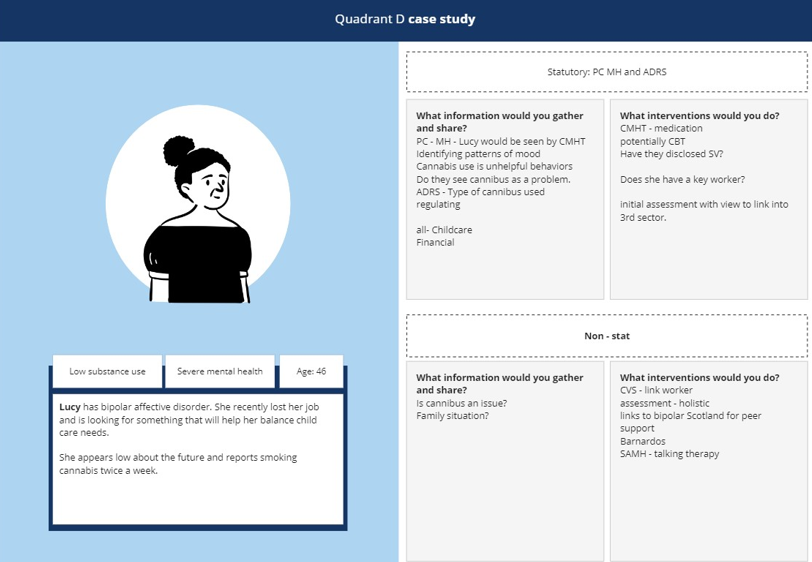Strategic Planning: Staff Conversations
About Staff Conversations
Structured conversations with staff can provide many benefits in your work and planning. Staff supporting, and getting support for, people with co-occurring conditions face challenges. Structured conversations with staff across sectors and services can surface challenges. Services have different roles across the sector, including third sector providers. When you have structured conversations you can better understand these different roles. This is particularly useful for understanding the role of third sector providers. These conversations can also support building relationships between staff. This can support:
- Building shared understanding of service landscape to support people
- Developing consensus around shared challenges in supporting co-occurring conditions, and
- Identification of opportunities for collaboration.

Supporting protocol – how you might use this tool:
When developing your local mental health and substance use protocol, this tool can:
Build relationships between staff who will be working together around new pathways/interfaces
Support staff to co-create scenarios of different needs profiles. Staff can use this to sketch out high-level local pathways
Create a collaborative space with third sector services. Explore together how to integrate third sector provision into statutory pathways.
The outputs of these conversation session will be useful insights. These insights can help identify a core template for how services can interface. A core template could include priorities for pathway development. It could also include challenges that need escalating to a strategic level. It can also include good practice to spread.
Structured Conversations
HIS facilitated a series of staff conversations as part of a previous mental health and substance use programme. One of our aims was to understand the experiences of delivering care and support for people with co-occurring conditions. This included identifying good practice, as well as building constructive dialogue between services. The conversations were also used to outline how new pathways can improve care.
We first held conversations with staff within their services, then held joint sessions. We found this useful and recommend this approach. A closed conversation provides a safe space for staff to discuss challenges. It can also support forming a collective view and reaching internal agreement.
Statutory Service Staff
The aim of this session is to agree and articulate a shared set of challenges in supporting people with co-occurring conditions. It is also to agree opportunities and the way forward. The attendees are statutory service staff.
Planning your session
Prepare an introduction that includes the findings from any staff engagement already undertaken. This will help set the context for the discussions within the session.
Agree any specific areas you would like to focus on based on what you are trying to achieve and the above.
Who should be involved
- Staff from both mental health and substance use services, including:
- Nursing staff
- Social work staff
- Psychiatrists
- Team leads
- If appropriate, include staff from other statutory services. This might include liaison or outreach teams, or acute services.
Activities
It might be useful to start with an activity to get to know each other’s services. You can find this discussion tool here.
The core activity within this workshop is open discussions. In groups of up to 6, discuss:
- What are the main challenges in getting people the right support at the right time?
- What obstacles or challenges do you face in linking with other services?
- How might we build capacity within services? What do you need to better support mental health or substance use?
- Where would you like to see improvements made?
Slides from the staff conversation workshop
Outputs
When we have done this before, key themes include:

You can find the outputs from Statutory Service Staff discussion sessions here.
Supporting resources for this tool
-
Agendas and slides:
Third Sector Staff Conversations
The aim of this session is to articulate how the third sector as a whole can support people in different ways. How can this enhance the impact of statutory services and support sustainable recovery?
Planning your session
Prepare an introduction that includes the findings from any engagement already undertaken. This will help set the context for the discussion.
Who should be involved
Staff from a range of third sector organisations. Any organisations that support people with mental health and substance use support needs. This should include:
- Case holding services (such as Penumbra)
- Peer led services (such as recovery communities)
- Advocacy
Activities
Discussion One – getting to know each other and surfacing issues
Invite participants to form small groups. They will discuss experiences supporting people with co-occurring conditions. Encourage them to think about:
- What support they provide, including details of any specific interventions
- The range of needs they support. This can include those outside of mental health and substance use
- How they respond when people present with needs/issues outside of their expertise
Feedback key messages to the group and highlight any shared experiences.
You can enhance this activity using the ‘Creating an Offering Map.' individual services can complete this either before or after the session.
Discussion Two – understanding relationships with statutory services
Invite participants to discuss their experiences working with statutory services, noting:
- The services they work with
- The nature of the relationship
- How they communicate
- Where can they improve the relationship
Note taking tool for this activity

Agendas and slides:
Outputs:
Joint session
The aim of this session is to have a constructive dialogue. How can you use the skills and expertise across all staff to better support people? The sessions should identify what processes and infrastructure you need.
Planning your session
- Bring together the insights from the individual sessions. Highlight any commonalities and commend good practice.
- Set the discussion within the local strategic context.
- Develop ‘Personas’ for each of the Four Quadrants to use as part of the discussion.
Who should be involved
- Participants from previous sessions.
- The Senior Responsible Officer to set the scene.
Activity
How you might build on this
The outputs from these sessions can help identify
- Where are service level changes needed; and what these changes should be.
- Articulate roles and responsibilities across all services. Break this down in relation to different dynamics of co-occurring conditions.
- How leaders at different levels can support collaboration.
- How you can involve peer networks and champions in designing and driving change.

Examples of analysis and insights
Having conversations as a ‘tool’ can be quite intangible and daunting. Below are some of the types of insights that you might get from using this structured approach:
Where collaboration can work
- Examples of emergent collaboration that you could formalise between services.
- Identification of the types of cases where further collaboration would improve care. A starting point for setting out the roles and responsibilities in that.
Where staff need support
- Identification of training and support needs across specialisms
- Examples of how to support staff networks.
- Where better connections between services would support staff. What strengths services can share with each other. And how this can provide better holistic care to individuals needing support.
How flexible approaches can work
- Highlight the challenges of supporting co-occurring conditions within service silos. Identify where joined up approaches can enhance care.
- Identify where input from other services/professionals would enhance support staff can provide.
- Sense check any proposals for high level pathways.
